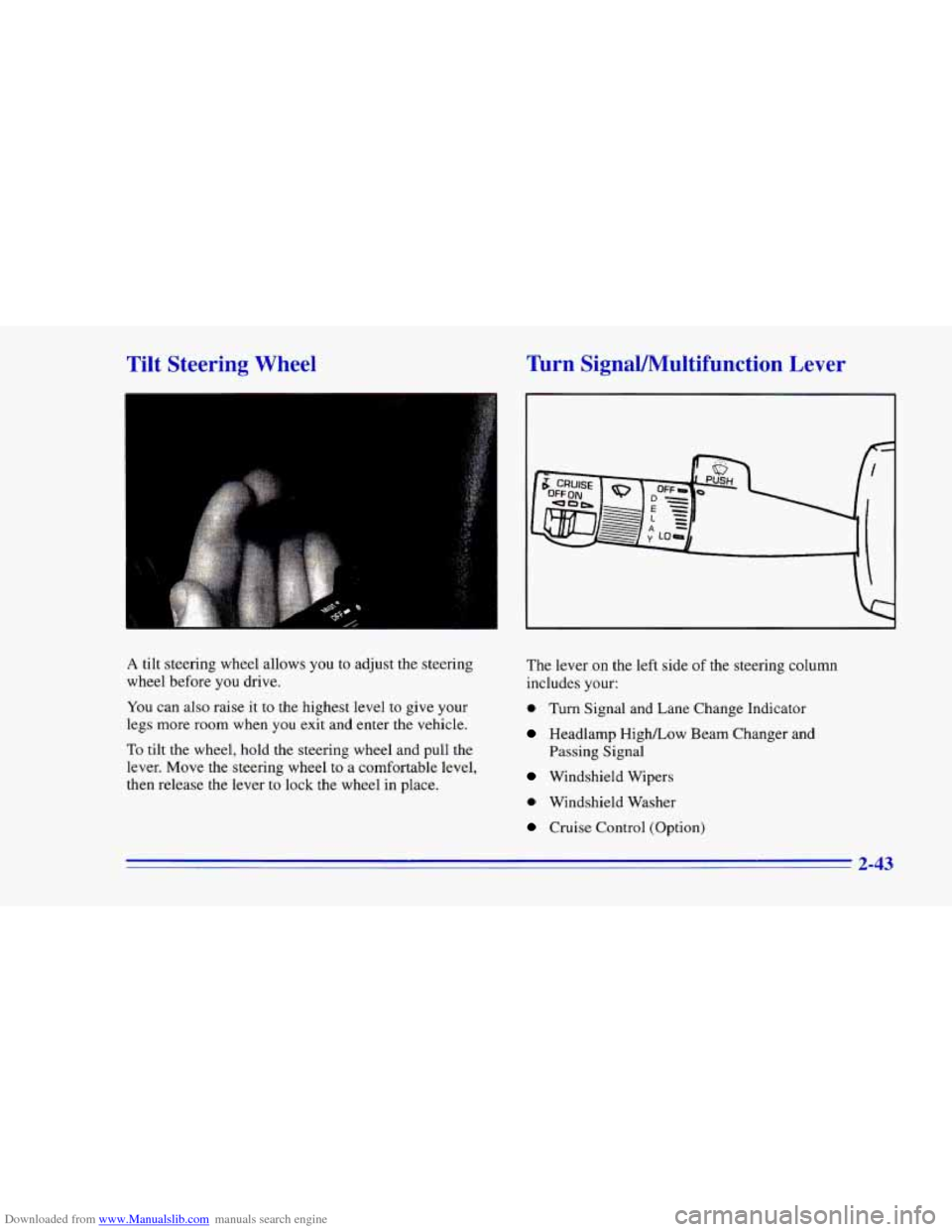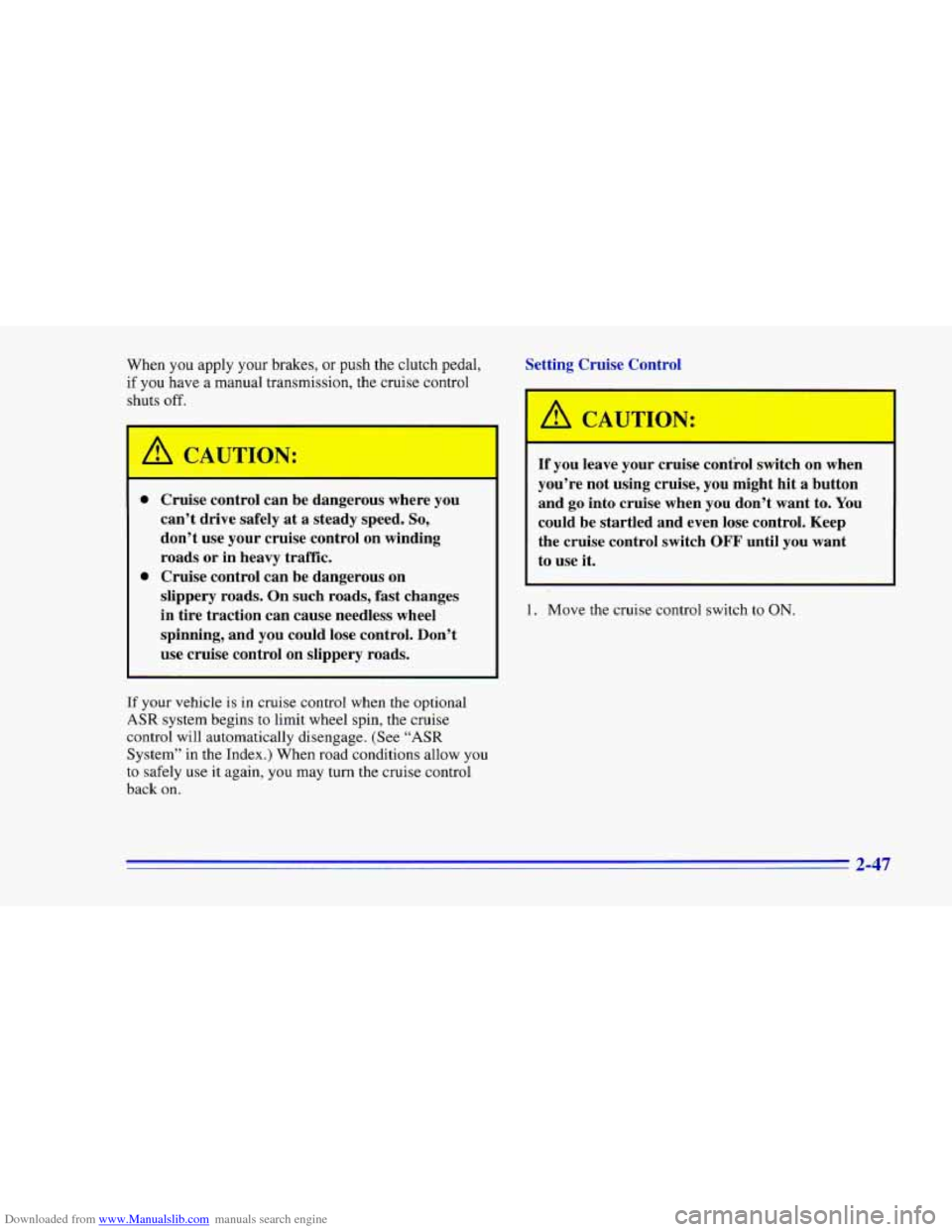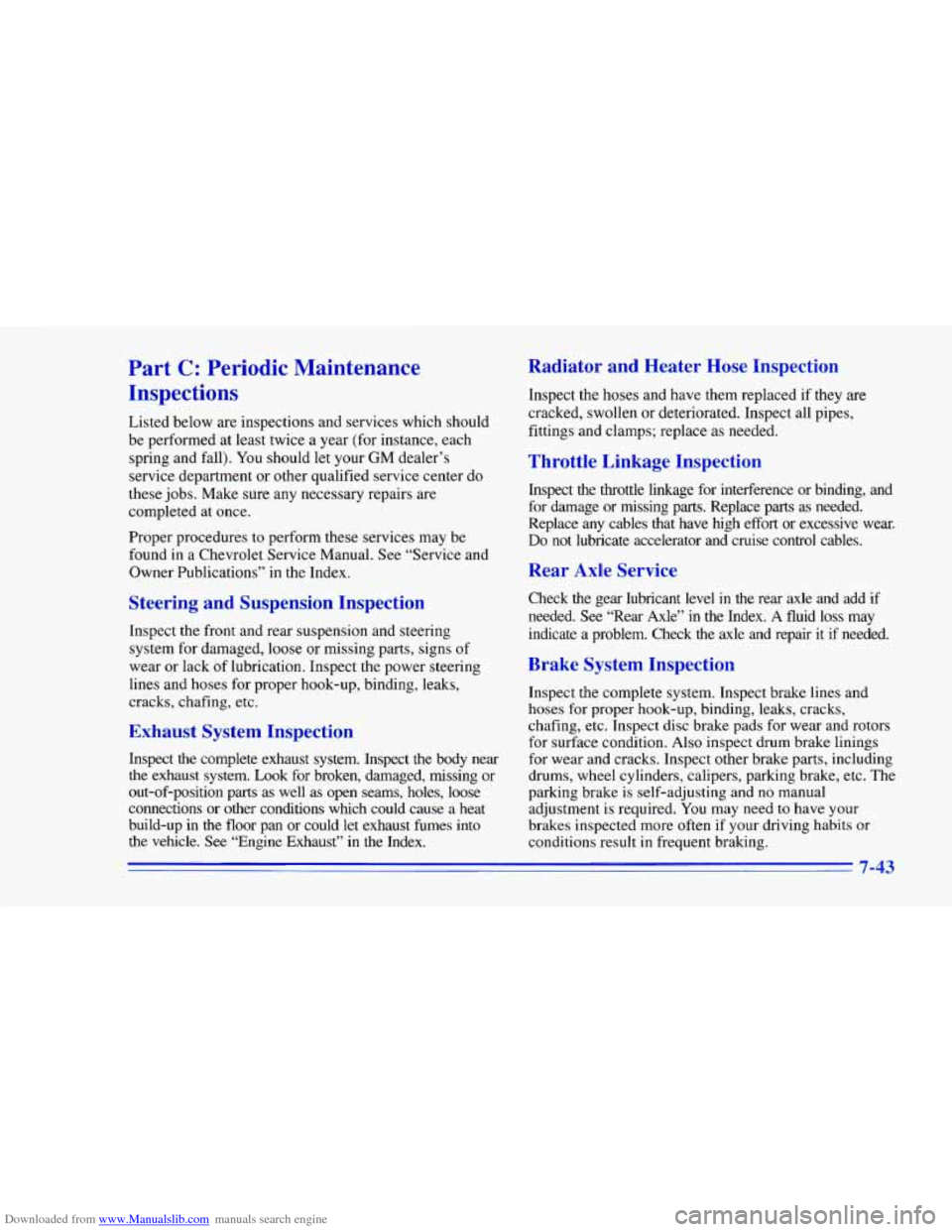cruise control CHEVROLET CAMARO 1996 4.G Owners Manual
[x] Cancel search | Manufacturer: CHEVROLET, Model Year: 1996, Model line: CAMARO, Model: CHEVROLET CAMARO 1996 4.GPages: 402, PDF Size: 21.38 MB
Page 98 of 402

Downloaded from www.Manualslib.com manuals search engine Tilt Steering Wheel Turn SignaVMultifunction Lever
A tilt steering wheel allows you to adjust the steering
wheel before you drive.
You can also raise it
to the highest level to give your
legs more room when you exit and enter the vehicle.
To tilt the wheel, hold the steering wheel and pull the
lever. Move the steering wheel to a comfortable level,
then release the lever to lock the wheel in place. The lever
on the left side
of the steering column
includes your:
0 Turn Signal and Lane Change Indicator
Headlamp High/Low Beam Changer and
Passing Signal
Windshield Wipers
0 Windshield Washer
Cruise Control (Option)
2-43
Page 101 of 402

Downloaded from www.Manualslib.com manuals search engine Windshield Washer
At the top of the turn signaUmultifimction lever, there’s
a paddle with the word
PUSH on it. To spray washer
fluid
on the windshield, just push the paddle. The
washer will continue
to spray until you release the
paddle for less than a second. The wipers will clear the
window and wipe a few more times before stopping or
returning to the previous setting.
I I
A CAUl w
w
In freezing weather, don’t use your washer until
the windshield
is warmed. Otherwise the washer
fluid can form ice
on the windshield, blocking
your vision.
Cruise Control (Option)
With cruise control, you can maintain a speed of about
25 mph (40 km/h) or more without keeping your foot on
the accelerator. This can really help
on long trips. Cruise
control does
not work at speeds below about 25 mph
(40 km/h).
2-46
Page 102 of 402

Downloaded from www.Manualslib.com manuals search engine When you apply your brakes, or push the clutch pedal,
if you have a manual transmission, the cruise control
shuts
off.
Setting Cruise Control
0 Cruise control can be dangerous where you
can’t drive safely at a steady speed.
So,
don’t use your cruise control on winding
roads or in heavy traffic.
slippery roads. On such roads, fast changes
in tire traction can cause needless wheel
spinning, and you could lose control. Don’t
use cruise control on slippery roads.
0 Cruise control can be dangerous on
If your vehicle is in cruise control when the optional
ASR system begins to limit wheel spin, the cruise
control will automatically disengage. (See
“ASR
System” in the Index.) When road conditions allow you
to safely use it again, you may turn the cruise control
back
on.
L
QT’TIO’’:
If you leave your cruise contirol switch on when
you’re not using cruise, you might hit
a button
and go into cruise when you don’t want to. You
could be startled and even lose control. Keep
the cruise control switch
OFF until you want
to use it.
1. Move the cruise control switch to ON.
2-47
Page 103 of 402

Downloaded from www.Manualslib.com manuals search engine 2. Get up to the speed you want.
3. Push in the SET button at the end of the lever and
release
it.
4. Take your foot off the accelerator pedal.
Resuming a Set Speed
v
Suppose you set your cruise control at a desired speed
and then apply the brake or clutch pedal. This, of course,
shuts off the cruise control. But you don’t need to reset
it. Once you’re going about 25 mph (40 kmh) or more,
you can move the cruise control switch from
ON to
R/A (Resume/Accelerate) for about half a second.
You’ll go right back up
to your chosen speed and
stay there.
2-48
Page 104 of 402

Downloaded from www.Manualslib.com manuals search engine Increasing Speed While Using Cruise Control
There are two ways to go to a higher speed:
0 Use the accelerator pedal to get to the higher speed.
Push the button at the end of the lever, then release
the button and the accelerator pedal. You’ll now
cruise at the higher speed.
0 Move the cruise switch from ON to R/A. Hold it
there until
you get up to the speed you want, and
then release the switch.
(To increase your speed in
very small amounts, move the switch to
WA for
less than half
a second and then release it. Each
time you
do this, your vehicle will go about 1 mph
(1.6
km/h) faster.)
Reducing Speed While Using Cruise Control
There are two ways to reduce your speed while using
cruise control:
Push in the button at the end of the lever until you
reach the lower speed you want, then release it.
To slow down in very small amounts, push the
button for less than half a second. Each time you
do
this, you’ll go 1 mph (1.6 km/h) slower.
Passing Another Vehicle While Using Cruise Control
Use the accelerator pedal to increase your speed. When
you take your foot off the pedal, your vehicle will slow
down to the cruise control speed you set earlier.
Using Cruise Control on Hills
How well your cruise control will work on hills depends
upon your speed, load and the steepness of the hills.
When going up steep hills, you may have to step
on the
accelerator pedal to maintain your speed. When going
downhill, you may have
to brake or shift to a lower gear
to keep your speed down. Of course, applying the brake
takes you out of cruise control. Many drivers find this
to
be too much trouble and don’t use cruise control on
steep hills.
Ending Out of Cruise Control
There are several ways to turn off the cruise control:
0 Step lightly on the brake pedal or push the clutch
pedal, if
you have a manual transmission ; OR
Move the cruise switch to OFF.
Erasing Speed Memory
When you turn off the cruise control or the ignition,
your cruise control set speed memory
is erased.
-9
Page 174 of 402

Downloaded from www.Manualslib.com manuals search engine Examples of these conditions include a hard acceleration
in a turn, or an abrupt upshift or downshift. Also, when
the compact spare tire is on the rear axle, the ASR
system will cycle and limit acceleration for about the
first
15 seconds of driving after each engine start.
If your vehicle is in cruise control when the ASR system
begins to limit wheel spin, the cruise control will
automatically disengage. When road conditions allow
you to safely use it again, you may re-engage the cruise
control. (See “Cruise Control” in the Index.)
ASR
OFF
The ASR system automatically comes on whenever you
start your vehicle.
To limit wheel spin, especially in
slippery road conditions, you should always leave
the
system on. But you can turn the ASR system off if you
ever need to. (You should turn the system
off if your
vehicle ever gets stuck in sand, mud, ice or snow.
See
“Rocking Your Vehicle” in the Index.)
To turn the system off, press
the button on the console
near the cigarette lighter.
When the system is on, this
warning light will come on
to let you know if there’s a
problem with your ASR
system. See “ASR System
Warning Light” in the
Index. When this warning
light is on, the system will
not limit wheel spin. Adjust
your driving accordingly. The ASR system warning light will come on
and stay
on. If the ASR system is limiting wheel spin when you
press the button, the warning light will come on
-- but
the system won’t turn
off right away. It will wait until
there’s no longer a current need to limit wheel spin.
4-9
Page 322 of 402

Downloaded from www.Manualslib.com manuals search engine Fuse
HORN INJECTOR
ENG SEN
IGNITION
A/C-CRUISE
Usage
Horn Relay
Fuel Injectors
~ Mass Air Flow, Heated Oxygen
fl Sensor, Reverse Lockout Solenoid.
Skip Shift Solenoid, Automatic
Transmission, Brake Switch
V6 VIN K: Electronic Ignition Control Module
V8 VIN P: Ignition Coil Module,
Crankshaft Position
Sensor, Ignition Coil
Air Conditioning Compressor
Relay; Cruise Control Switches
and Module
Relay
B
C
D
E
F
G
H
J
Usage
Air Conditioning Compressor
Anti-Lock Brake SystedTraction
Control System (ASR)
Cooling Fan
1
Air Pump
Cooling Fan
2
Not Used
Fog Lamps
Cooling Fan
3
6-71
Page 370 of 402

Downloaded from www.Manualslib.com manuals search engine Part C: Periodic Maintenance
Inspections
Listed below are inspections and services which should
be performed at least twice a year (for instance, each
spring and fall). You should let your
GM dealer’s
service department or other qualified service center do
these jobs. Make sure any necessary repairs are
completed at once.
Proper procedures to perform these services may be
found in a Chevrolet Service Manual. See “Service and
Owner Publications” in the Index.
Steering and Suspension Inspection
Inspect the front and rear suspension and steering
system for damaged, loose or missing parts, signs of
wear or lack of lubrication. Inspect the power steering
lines and hoses for proper hook-up, binding, leaks,
cracks, chafing, etc.
Exhaust System Inspection
Inspect the complete exhaust system. Inspect the body near
the exhaust system. Look for broken, damaged, missing or
out-of-position
parts as well as open seams, holes, loose
connections
or other conditions which could cause a heat
build-up in the floor
pan or could let exhaust fumes into
the vehicle.
See “Engine Exhaust” in the Index,
Radiator and Heater Hose Inspection
Inspect the hoses and have them replaced if they are
cracked, swollen or deteriorated. Inspect all pipes,
fittings and clamps; replace as needed.
Throttle Linkage Inspection
Inspect the throttle linkage for interference or binding, and
for damage or missing parts. Replace parts as needed.
Replace
any cables that have high effort or excessive wear.
Do not lubricate accelerator and cruise control c.ables.
Rear Axle Service
Check the gear lubricant level in the rear axle and add if
needed. See “Rear Axle” in the Index. A fluid loss may
indicate a problem. Check the axle and repair it if needed.
Brake System Inspection
Inspect the complete system. Inspect brake lines and
hoses for proper hook-up, binding, leaks, cracks,
chafing, etc. Inspect disc brake pads for wear and rotors
for surface condition. Also inspect drum brake linings
for wear and cracks. Inspect other brake parts, including
drums, wheel cylinders, calipers, parking brake, etc. The
parking brake is self-adjusting and no manual
adjustment is required. You may need
to have your
brakes inspected
more often if your driving habits or
conditions result in frequent braking.
7-43
Page 392 of 402

Downloaded from www.Manualslib.com manuals search engine Close-OutPanel ................................ 2-58
Comfort Controls
................................ 3- 1
Compact Disc Care
....................................... 3-21
Player
.................................. 3.9. 3.15
Player Errors
........................... 3-1 1. 3. I6
Storage
..................................... 2-57
Control of a Vehicle
.............................. 4-5
Convertible Top
................................ 2-66
Convex Outside Mirror
.......................... 2-56
Coolant
....................................... 6-26
Bleedvalves
................................. 5-25
Heater. Engine
............................... 2-27
RecoveryTank
............................... 5-18
Cooling System
................................ 5- 15
Courtesy Lamps
................................ 2-53
Courtesy Transportation
........................... 8-6
Cruise Control
................................. 2-46
Customer Assistance Information
................... 8- I
Customer Satisfaction Procedure .................... 8- 1
Damage. Finish ............................... 6-63
Damage. Sheet Metal
............................ 6-63
Daytime Running Lamps
......................... 2-50
Dead Battery
................................... 5-2
Defects. Reporting Safety
......................... 8-8
Defensive Driving
............................... 4- 1
Defogger. Rear Window .......................... 3-5
Defogging
..................................... 3-4
Defrosting
..................................... 3-4
Clutch. Hydraulic
............................... 6-25
Compact Spare Tire
............................. 5-39
Customer Assistance for Text Telephone Users
......... 8-3 Delayed Illumination
............................ 2-53
Dimensions. Vehicle
............................ 6-74
Dolby@
B Noise Reduction ....................... 3-14
Door DELCO-LOC
I1 .............................. 3-17
Last Door Closed Locking Feature
................ 2-5
Lockout Prevention ............................ 2-5
Locks
....................................... 2-3
Downshifting
.................................. 2-35
Drive Position. Automatic Transmission
............. 2-30
DriverPosition
................................. 1-12
Driver’s Door Alarm DelayBhock Sensor Enable
..... 2-21
Driving
City
........................................ 4-20
Defensive
.................................... 4-1
Drunken
..................................... 4-2
Freeway
.................................... 4-21
In a Blizzard
................................. 4-27
In Foreign Countries
........................... 6-4
IntheRain
.................................. 4-17
Night
...................................... 4-15
OnCurves
.................................. 4-10
On Hill and Mountain Roads
.................... 4-23
OnSnowandIce
............................. 4-26
Throughwater
............................... 4-19
WetRoads
.................................. 4-17
Winter
...................................... 4-25
With a Trailer
................................ 4-36
DrunkenDriving
................................ 4-2
Electrical Equipment. Adding .......... 2-25. 3-20. 6-66
Electrical System
............................... 6-66
On
Grades While Towing a Trailer
............... 4-38
9-3